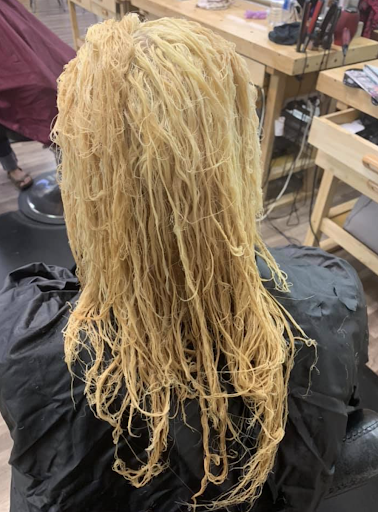Hair Bleaching Fails Through the Lens of Schadenfreude

Photo courtesy of Kristen Rankin
A girl’s hair turned into the texture of rice noodles with the help of bleach
There’s some sort of sick satisfaction in watching people absolutely obliterate their hair with bleach. Helplessly watching as the previously healthy strands turn into a gummy soft consistency; internally yelling as they brush their perpetually damp ramen noodle mush and empathizing with these poor souls as mounds of their hair fall out. For years I have found myself drawn to these YouTube videos, why? The Germans have a term for this phenomenon: schadenfreude.
According to Merriam-Webster, “Schadenfreude is a combination of the German nouns Schaden, meaning ‘damage’ or ‘harm,’ and Freude, meaning ‘joy.’” In that regard, schadenfreude means joy over the harm or misfortune suffered by another. The Germans are not alone in their malicious pleasure though; in French it’s joie maligne, in Russian it’s zolradstov, in Hebrew it’s simcha la-ed. Clearly, this notion of laughter in the face of others’ suffering is not a new concept. It is a unifying universal experience that permeates through and connects all cultures, but it is not without its ethical quandaries. Of course, in most humans, a certain aspect of shame is closely connected with the feeling. Is it morally right to laugh or smile while other people’s lives fall apart? Does it make us any less human? I think not, and now that this feeling has a name, let’s make our way back to bleach fails.
I can’t remember exactly when I started watching bleach fails, but it was around the time I decided to get my hair dyed. At first, my fascination stemmed from a certain level of fear. I wanted to ensure that when my stylist was about to apply harmful chemicals to my hair, I would have at least a basic level of knowledge of what was actually happening. In case you’re curious, I’ll save you the Google search. When you bleach your hair, an alkaline agent opens up the hair cuticle and an oxidative agent penetrates the hair cortex and dissolves the melanin. The breakage occurs when the hair cuticle is more open, becomes a split end, and eventually breaks off when too many bleach rounds are applied. It was almost a reassuring act of hope. It was a way to convince myself that even if my hair ended up dry and damaged, at least I’d hopefully still have hair.
The videos are also quite informative. Even though I experience schadenfreude when I watch them, and it may seem counterintuitive to my personal pleasure, I’m not a selfish monster. The original purpose of this article was to try and give helpful bleaching advice, but it appears to have taken a strange philosophical detour for a bit. In an attempt to return to the previous intent, I have learned from the many “what not to dos” in order to craft a suitable “how to” list.
First, applying coconut oil to your hair does not protect it like you think it will. The bleach can effortlessly eat through it and it just wastes time. Applying vaseline around your hairline though can help reduce irritation to the skin.
Second, it’s usually recommended to not bleach freshly washed hair. Waiting a few days allows the natural oils from your scalp that help with hair growth and health to accumulate.
Third, read the instructions and add an appropriate amount of developer to bleach (approximately one part bleach to two parts developer). The concoction shouldn’t be too loose or too thick and make sure to apply a thick coat to each paper thin section.
Fourth, make sure to bleach the roots last because the heat from the scalp makes it process faster and can lead to hot roots (lighter roots than the rest of the head).
Fifth, don’t leave the bleach on for too long (forty five minutes is the max for at home bleaching). Leaving it on for too long can lead to irreversible damage and guarantees a poor outcome.
With all this being said, if you can afford to see a professional it’s usually the most reliable way to ensure your hair doesn’t fall out. I hope this was in any way helpful and please don’t end up in my YouTube recommendations.
Your donation will support the student journalists of Chamblee High School Blue & Gold. Your contribution will allow us to print editions of our work and cover our annual website hosting costs. Currently, we are working to fund a Halloween satire edition.

Sydney Leahy is a senior and editor on the Blue & Gold. The movie that best encapuslates her high school experience is "Panic Room" by David Fincher. In five years, she hopes to have earned the title of reclusive curmudgeon, living on in fables told by cowering neighborhood children. This is her second year on the staff.



